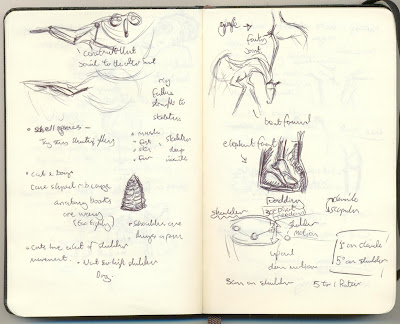Hey so here is the last instalment of the Stuart Sumida notes, Some of this is really useful some of it's a little random but could come in useful one day. Schell Games were another of Stuart's clients which I found intriguing as they are responsible for a selection of the animatronics and roller coasters at Epcot. The knowledge of this kind of biology is obviously extremely useful to engineers.
Cats and Dogs are commonly animated characters and over the years certain features have arisen as vital to their believability. A cat's shoulders have plenty of flexibility and contribute a lot to their unique movement, they are situated at a higher point than a dogs shoulders. Both species have a cone shaped rib cage which defines their form and is useful to include in any characterisation.
Here is a random fact, an elephants foot is almost human like in bone structure, the actual shape of the elephants leg is due to the padded cushion of tissue the elephant has under the heel. This is shown in the sketch above partially, a funny thing to find out though. On a more character rigging tangent the movement of the human arm, or any primate like being, relies on a ratio of 5 to 1 where the clavicle moves only slightly whilst the shoulder (scapula) moves to greater degree. This is always difficult to replicate in a rig but with driven keys or inputs through a connection editor this ratio of movement could be achieved.
Stuart showed a few examples of joint diagrams from Adalbert I. Kapandji written work's as physiology expert. I will most likely look into purchasing "the physiology of joints" which seems to hold a lot of useful information. Some of last few points made were that the ball and plate bone in your knee is not as secure as you may think. The ball will roll to and fro over the surface held in place by muscle and tissue but when the knee is bent too far due to the shaped flat of the tibia the joint will result in bone collision or dislocation. This is useful to show the limits the leg has in its movement and that the a knee's rotation is not anchored to 1 axis.
A final fact, the cheek bone, bottom of eye socket and ear hole on the human head are precisely the same level so when character designing/modelling this might come in handy. Stuart Sumida gave a great workshop and hopefully I can attend Animex 2011 and attend another of these. Hope some of this is of help I shall be able to focus on the Animators of Animex now so these next few blogs will be great.




No comments:
Post a Comment